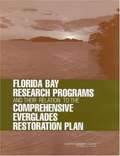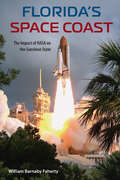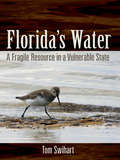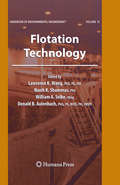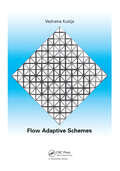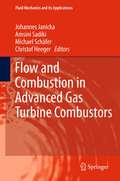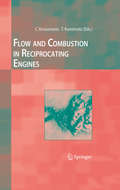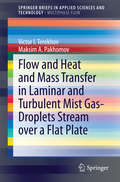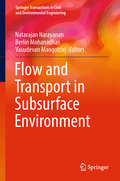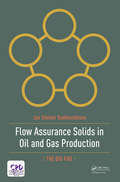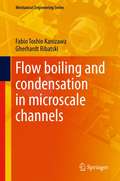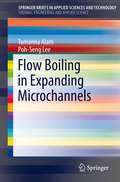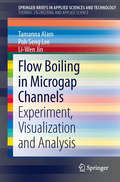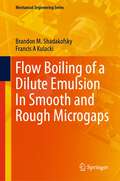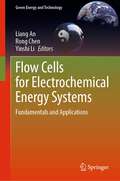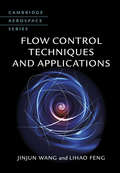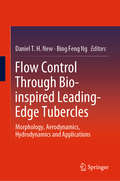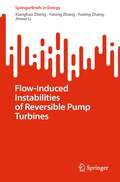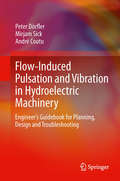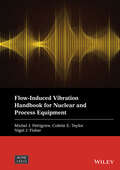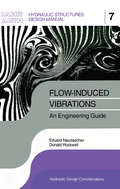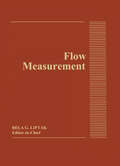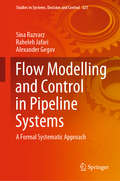- Table View
- List View
Florida Bay Research Programs And Their Relation To The Comprehensive Everglades Restoration Plan
by Committee on Restoration of the Greater Everglades EcosystemThe National Academies Press (NAP)--publisher for the National Academies--publishes more than 200 books a year offering the most authoritative views, definitive information, and groundbreaking recommendations on a wide range of topics in science, engineering, and health. Our books are unique in that they are authored by the nation's leading experts in every scientific field.
Florida's Space Coast: The Impact of NASA on the Sunshine State (Florida History and Culture)
by William B. Faherty"An important, interesting study of the relations between the Kennedy Space Center and the communities of Brevard County, Florida."--Roger D. Launius, chief historian, NASA, Washington, D.C."This outstanding book provides readers of Florida history our first insight into the impact that high technology has had on the state. Brevard County is a veritable laboratory for understanding what happens when space science and engineering put down roots in a wilderness setting. Faherty's writing is direct, simple, even folksy at times. I devoured it!"--Michael Gannon, author of Pearl Harbor Betrayed and A Short History of FloridaFlorida&’s Space Coast tells the compelling story of America's half century in space exploration, from the successful launch of the first two-stage rocket in 1950 through the latest space shuttle missions of 2000. Told from the unique viewpoint of the people who built the Spaceport, this book shows how the space program transformed the east central Florida coast from a traditional citrus production and tourist area to one of the most influential high-tech centers in the nation.Cape Canaveral was chosen as a missile launch site because of its many geographical advantages. However, in the early years of the space program, the area was far from an ideal place for NASA employees to raise their families. NASA brought in thousands of space-related workers, who, besides sending machines and men into space, had to meet the challenge of moving their families from urban environs to a rural southern county. This book engagingly recounts the parallel stories of the establishment of America's space program and its impact on the development of Brevard County.William Barnaby Faherty is professor emeritus of history at St. Louis University and director of the Museum of the Western Jesuit Missions in Hazelwood, Missouri.
Florida's Water: A Fragile Resource in a Vulnerable State
by Tom SwihartFlorida's Water poses fundamental questions about water sustainability in the United States' fourth largest state. Florida has long-standing water quality problems. Global climate change threatens to intensify Florida's floods and droughts, make hurricanes more common or more damaging, and eventually submerge much of low-lying Florida, including the Everglades. How can Florida meet these extraordinary challenges? And what lessons does the Florida experience hold for other states? This book fully integrates the many diverse responsibilities of water management into a readable and compelling combination of interesting narratives and deep analysis. Author Tom Swihart's unique, intimate knowledge of Florida's successes and failures in water management brings out both the novelty of Florida's water situation and the features that it has in common with other states.
Flotation Technology
by Lawrence K. Wang Nazih K. Shammas Donald B. Aulenbach William A. SelkeThe Handbook of Environmental Engineering series is an incredible collection of methodologies that study the effects of pollution and waste in their three basic forms: gas, solid, and liquid. This exciting new addition to the series, Volume 12: Flotation Technology, has been designed to serve as both a basic flotation textbook and a comprehensive reference book. An indispensable guide for advanced undergraduate and graduate students, designers of water and wastewater treatment systems, scientists, and researchers, this volume is essential for all readers who are interested in the specialized investigation of the theory and practice of various wastewater systems. A critical volume in the Handbook of Environmental Engineering series, chapters employ methods of practical design and calculation illustrated by numerical examples, include pertinent cost data whenever possible, and explore in great detail the fundamental principles of the field. Volume 12: Flotation Technology, provides information on some of the most innovative and ground-breaking advances in the field today from a panel of esteemed experts. Coverage of the principles of air flotation technology and the fundamentals of water and wastewater flotation and lake restoration. Emphasis on industry standards, trends in the field, full-scale operation and laboratory simulation of air flotation processes. Examples of actual operating water and wastewater treatment plants based on air flotation Reference of practical use to scientists, researchers, educators and designers of water and wastewater treatment systems. Contents: Principles of Air Flotation Technology. Gas Dissolution, Release, and Bubble Formation. Separation of Oil From Wastewater. Fundamentals of Wastewater Flotation. Electroflotation. Electrocoagulation-flotation. Treatment of Paper Mill Whitewater. Recycling and Recovery of Raw Materials. Ozone-oxygen Oxidation Flotation, Wastewater Renovation by Flotation. Flotation-Filtration System for Wastewater Reuse. Algae Removal by Flotation. Completely Closed Water Systems in Paper Mills. Lake Restoration Using DAF. Jiminy Peak, Hancock, Massachusetts Wastewater Treatment Plant. Pittsfield, Massachusetts Water Treatment System. Pretreatment of Meat Processing Waste. Treatment of Seafood Processing Wastewater. Laboratory Simulation of Air Flotation Processes. Appendix. Index.
Flow Adaptive Schemes
by Vendrana KutijaA study in the development of flow adaptive numerical schemes in computational hydraulics directed to enhancing modelling capabilities. Examples covered include additional flow resistance due to flexible vegetation; one-dimensional supercritical flow; and flow in networks of channels.
Flow and Combustion in Advanced Gas Turbine Combustors
by Amsini Sadiki Christof Heeger Johannes Janicka Michael SchäferWith regard to both the environmental sustainability and operating efficiency demands, modern combustion research has to face two main objectives, the optimization of combustion efficiency and the reduction of pollutants. This book reports on the combustion research activities carried out within the Collaborative Research Center (SFB) 568 "Flow and Combustion in Future Gas Turbine Combustion Chambers" funded by the German Research Foundation (DFG). This aimed at designing a completely integrated modeling and numerical simulation of the occurring very complex, coupled and interacting physico-chemical processes, such as turbulent heat and mass transport, single or multi-phase flows phenomena, chemical reactions/combustion and radiation, able to support the development of advanced gas turbine chamber concepts
Flow and Combustion in Reciprocating Engines
by Take Kamimoto C. ArcoumanisOptimization of combustion processes in automotive engines is a key factor in reducing fuel consumption. This book, written by eminent university and industry researchers, investigates and describes flow and combustion processes in diesel and gasoline engines.
Flow and Heat and Mass Transfer in Laminar and Turbulent Mist Gas-Droplets Stream over a Flat Plate
by Victor I. Terekhov Maksim A. PakhomovIn this book the author presents selected challenges of thermal-hydraulics modeling of two-phase flows in minichannels with change of phase. These encompass the common modeling of flow boiling and flow condensation using the same expression. Approaches to model these two respective cases show, however, that experimental data show different results to those obtained by methods of calculation of heat transfer coefficient for respective cases. Partially that can be devoted to the fact that there are non-adiabatic effects present in both types of phase change phenomena which modify the pressure drop due to friction, responsible for appropriate modelling. The modification of interface shear stresses between flow boiling and flow condensation in case of annular flow structure may be considered through incorporation of the so called blowing parameter, which differentiates between these two modes of heat transfer. On the other hand, in case of bubbly flows, the generation of bubbles also modifies the friction pressure drop by the influence of heat flux. Presented are also the results of a peculiar M-shape distribution of heat transfer coefficient specific to flow boiling in minichannels. Finally, some attention is devoted to mathematical modeling of dryout phenomena. A five equation model enabling determination of the dryout location is presented, where the mass balance equations for liquid film, droplets and gas are supplemented by momentum equations for liquid film and two-phase core.
Flow and Transport in Subsurface Environment (Springer Transactions in Civil and Environmental Engineering)
by Vasudevan Mangottiri Berlin Mohanadhas Natarajan NarayananThis book presents a collection of contributions from experts working on flow and transport in porous media around the globe. The book includes chapters authored by engineers, scientists, and mathematicians on single and multiphase flow and transport in homogeneous as well as heterogeneous porous media. Addressing various experimental, analytical, and modeling aspects of transport in sub-surface domains, the book offers a valuable resource for graduate students, researchers, and professionals alike.
Flow Assurance Solids in Oil and Gas Production: Fundamentals of Solids In Oil and Gas Production
by Jon GudmundssonThe precipitation and deposition of solids are a major challenge in the production of oil and gas. Flow assurance solids are formed because of unavoidable changes in temperature, pressure and composition of the oil-gas-water flowstream, from reservoir conditions to processing conditions. The advent of subsea production and the increased exploitation of heavy crudes have made flow assurance issues dominant in ensuring efficient and safe exploitation of hydrocarbon assets. Five troublesome flow assurance solids are described in the book: asphaltene, paraffin wax, natural gas hydrate, naphthenate and inorganic scale. These big-five solids are presented in stand-alone chapters. Each chapter is designed to be readable without clutter. Derivations of equations and descriptions of supporting details are given in several appendices. The book is intended for professional engineers and natural scientist working in E&P companies, engineering companies, service companies and specialized companies. An understanding of the big-five solids is required throughout the lifetime of oil and gas assets, from early development to abandonment. The technical, safety and environmental risks associated with deposition problems in near-wellbore formations, production tubing, wellhead equipment, flowlines and processing facilities, are relevant for decisions in the oil and gas industry and in outside regulatory and financial entities.
Flow boiling and condensation in microscale channels (Mechanical Engineering Series)
by Fabio Toshio Kanizawa Gherhardt RibatskiThis book covers aspects of multiphase flow and heat transfer during phase change processes, focusing on boiling and condensation in microscale channels. The authors present up-to-date predictive methods for flow pattern, void fraction, pressure drop, heat transfer coefficient and critical heat flux, pointing out the range of operational conditions that each method is valid. The first four chapters are dedicated on the motivation to study multiphase flow and heat transfer during phase change process, and the three last chapters are focused on the analysis of heat transfer process during boiling and condensation. During the description of the models and predictive methods, the trends are discussed and compared with experimental findings.
Flow Boiling in Expanding Microchannels
by Tamanna Alam Poh-Seng LeeThis Brief presents an up to date summary of details of the flow boiling heat transfer, pressure drop and instability characteristics; two phase flow patterns of expanding microchannels. Results obtained from the different expanding microscale geometries are presented for comparison and addition to that, comparison with literatures is also performed. Finally, parametric studies are performed and presented in the brief. The findings from this study could help in understanding the complex microscale flow boiling behavior and aid in the design and implementation of reliable compact heat sinks for practical applications.
Flow Boiling in Microgap Channels: Experiment, Visualization and Analysis
by Poh Seng Lee Liwen Jin Tamanna AlamFlow Boiling in Microgap Channels: Experiment, Visualization and Analysis presents an up-to-date summary of the details of the confined to unconfined flow boiling transition criteria, flow boiling heat transfer and pressure drop characteristics, instability characteristics, two phase flow pattern and flow regime map and the parametric study of microgap dimension. Advantages of flow boiling in microgaps over microchannels are also highlighted. The objective of this Brief is to obtain a better fundamental understanding of the flow boiling processes, compare the performance between microgap and conventional microchannel heat sinks, and evaluate the microgap heat sink for instabilities and hotspot mitigation.
Flow Boiling of a Dilute Emulsion In Smooth and Rough Microgaps (Mechanical Engineering Series)
by Brandon M. Shadakofsky Francis A KulackiThis book elucidates heat transfer behavior for boiling of dilute emulsions- mixtures of two immiscible fluids- which has received little attention to date. Of the work completed in this area, the majority has been focused on pool boiling where no mean flow is present, and this book is the first major work to be published regarding flow boiling of emulsions. The book includes a comprehensive review and assessment of research on emulsion-based heat transfer. Recent experiments are reported and analyzed to characterize heat transfer in microgap flow boiling via a systematic investigation into the effects of gap size, mass flux, and volume fraction on the heat transfer coefficient and pressure drop. The emulsion used in all experiments comprises droplets of an immiscible electronics cooling fluid suspended in water. The volume provides a complete baseline for flow boiling of water in the microgaps, enabling a determination of the enhancement of the heat transfer coefficient when the disperse component is present. Moreover, a subset of the data set pertains to flow boiling of dilute emulsions over microporous surfaces. The flow conditions for which the microporous surfaces enhance or degrade heat transfer are presented. Finally, this book provides a discussion of the physical phenomena which affect boiling and a set of nondimensional numbers that can be used for correlation.
Flow Cells for Electrochemical Energy Systems: Fundamentals and Applications (Green Energy and Technology)
by Liang An Rong Chen Yinshi LiThis book is a state-of-the-art review on recent advances in flow cells for electrochemical energy systems. The book includes an introduction to flow cells, proton exchange membrane fuel cells, photocatalytic fuel cells, organic flow batteries, redox flow batteries, microfluidic flow cells, as well as electrolysis cells for CO2 and nitrogen reduction. The book provides an essential reference for professors, researchers, and policymakers globally in academia, industry, and government.
Flow Control Techniques and Applications (Cambridge Aerospace Series #46)
by Jinjun Wang Lihao FengProviding comprehensive coverage, this is the first book to systematically introduce different flow control techniques. With a dedicated chapter for each technique, all of the most important, typical and up-to-date methods are discussed, including the vortex generator, biological techniques, the jet and synthetic jet, the plasma actuator, and closed-loop control. Understand their key characteristics and control mechanisms, and learn about their applications in different fields such as aviation and aerospace, mechanical engineering, and building construction. The necessary background on flow control is provided, including the history of the discipline, and the definition, classification and development of each technique, making this essential reading for graduate students, researchers and engineers working in the field.
Flow Control Through Bio-inspired Leading-Edge Tubercles: Morphology, Aerodynamics, Hydrodynamics and Applications
by Daniel T. H. New Bing Feng NgThis book describes and explains the basis of bio-inspired, leading-edge tubercles based on humpback whale flippers as passive but effective flow control devices, as well as providing a comprehensive practical guide in their applications. It first discusses the morphology of the humpback whale flipper from a biological perspective, before presenting detailed experimental and numerical findings from past investigations by various experts on the benefits of leading-edge tubercles and their engineering implementations.Leading-edge tubercle designs and functions have attracted considerable interest from researchers in terms of understanding their role in the underwater agility of these whales, and to exploit their flow dynamics in the development of new and novel engineering solutions. Extensive research over the past recent years has demonstrated that the maneuverability of these whales is at least in part due to the leading-edge tubercles acting as passive flow control devices to delay stall and increase lift in the post-stall regime. In addition to the inherent benefits in terms of aerodynamics and hydrodynamics, investigations into leading-edge tubercles have also broadened into areas of noise attenuation, stability and industrial applications.This book touches upon these areas, with an emphasis upon the effects of lifting-surface types, flow regimes, tubercle geometries, lifting-surface stability and potential industrial applications, among others. As such, it features contributions from key experts in the fields of biology, physics and engineering who have conducted significant studies into understanding the various aspects of leading-edge tubercles. Given the broad coverage and in-depth analysis, this book will benefit academic researchers, practicing engineers and graduate students interested in tapping into such a unique but highly functional flow control strategy.
Flow in Porous Rocks: Energy and Environmental Applications
by Andrew W. WoodsFocusing on simplified models of physical flow processes, this book develops a series of quantitative models to describe the recovery of oil and gas from hydrocarbon reservoirs (including fracking), the physics of geo-sequestration of CO2, geothermal power production, and the potential for underground contaminant dispersal in the long-term storage of nuclear waste. The author approaches these problems by developing simplified mathematical models and identifying the key dimensionless variables that control the processes. This analysis is then used to demonstrate the challenges and constraints of modelling flow in complex and heterogeneous rocks, which often have uncertain flow properties. Analytical solutions for flows are provided where possible, and analogue laboratory experiments are also presented to help illustrate and provide a different perspective on the flows. Incorporating end-of-chapter exercises, this is an important introduction to the different controls on flow in porous rocks for academic researchers, energy industry professionals and graduate students.
Flow-Induced Instabilities of Reversible Pump Turbines (SpringerBriefs in Energy)
by Xianghao Zheng Yuning Zhang Jinwei LiThis brief provides a comprehensive introduction on the flow-induced instabilities (e.g., the pressure fluctuations and the vibrations) of the reversible pump turbines (RPTs) in the pumped hydro energy storage power stations (PHSEPSs) in China based on long-term field tests. The pressure fluctuations and the vibrations of several RPTs in China under different operational conditions are analysed in detail to reveal their generation mechanisms and propagation characteristics. The book presents advanced signal analysis and processing methods which are used for obtaining the time-frequency information and for finding the internal correlations between several types of signals. Advanced artificial intelligence algorithms are adopted for understanding the effective fault diagnosis and the identification of different flow patterns. The book overviews the fundamentals of the RPTs and the signal analysis methods, while it demonstrates that the analysis results of the pressure fluctuation and vibration data may be employed for the calibration of numerical simulations and the comparisons of model tests. It is primarily targeted to researchers and engineers working on the fields of condition monitoring and fault diagnosis of hydraulic machineries.
Flow-Induced Pulsation and Vibration in Hydroelectric Machinery
by André Coutu Peter Dörfler Mirjam SickSince the 1970's, an increasing amount of specialized research has focused on the problems created by instability of internal flow in hydroelectric power plants. However, progress in this field is hampered by the interdisciplinary nature of the subject, between fluid mechanics, structural mechanics and hydraulic transients. Flow-induced Pulsation and Vibration in Hydroelectric Machinery provides a compact guidebook explaining the many different underlying physical mechanisms and their possible effects. Typical phenomena are described to assist in the proper diagnosis of problems and various key strategies for solution are compared and considered with support from practical experience and real-life examples. The link between state-of the-art CFD computation and notorious practical problems is discussed and quantitative data is provided on normal levels of vibration and pulsation so realistic limits can be set for future projects. Current projects are also addressed as the possibilities and limitations of reduced-scale model tests for prediction of prototype performance are explained. Engineers and project planners struggling with the practical problems will find Flow-induced Pulsation and Vibration in Hydroelectric Machinery to be a comprehensive and convenient reference covering key topics and ideas across a range of relevant disciplines.
Flow-Induced Vibration Handbook for Nuclear and Process Equipment (Wiley-ASME Press Series)
by Michel J. Pettigrew Colette E. Taylor Nigel J. FisherExplains the mechanisms governing flow-induced vibrations and helps engineers prevent fatigue and fretting-wear damage at the design stage Fatigue or fretting-wear damage in process and plant equipment caused by flow-induced vibration can lead to operational disruptions, lost production, and expensive repairs. Mechanical engineers can help prevent or mitigate these problems during the design phase of high capital cost plants such as nuclear power stations and petroleum refineries by performing thorough flow-induced vibration analysis. Accordingly, it is critical for mechanical engineers to have a firm understanding of the dynamic parameters and the vibration excitation mechanisms that govern flow-induced vibration. Flow-Induced Vibration Handbook for Nuclear and Process Equipment provides the knowledge required to prevent failures due to flow-induced vibration at the design stage. The product of more than 40 years of research and development at the Canadian Nuclear Laboratories, this authoritative reference covers all relevant aspects of flow-induced vibration technology, including vibration failures, flow velocity analysis, vibration excitation mechanisms, fluidelastic instability, periodic wake shedding, acoustic resonance, random turbulence, damping mechanisms, and fretting-wear predictions. Each in-depth chapter contains the latest available lab data, a parametric analysis, design guidelines, sample calculations, and a brief review of modelling and theoretical considerations. Written by a group of leading experts in the field, this comprehensive single-volume resource: Helps readers understand and apply techniques for preventing fatigue and fretting-wear damage due to flow-induced vibration at the design stage Covers components including nuclear reactor internals, nuclear fuels, piping systems, and various types of heat exchangers Features examples of vibration-related failures caused by fatigue or fretting-wear in nuclear and process equipment Includes a detailed overview of state-of-the-art flow-induced vibration technology with an emphasis on two-phase flow-induced vibration Covering all relevant aspects of flow-induced vibration technology, Flow-Induced Vibration Handbook for Nuclear and Process Equipment is required reading for professional mechanical engineers and researchers working in the nuclear, petrochemical, aerospace, and process industries, as well as graduate students in mechanical engineering courses on flow-induced vibration.
Flow-induced Vibrations: IAHR Hydraulic Structures Design Manuals 7 (IAHR Design Manual #7)
by Eduard NaudascherDesigned for engineers, this work considers flow-induced vibrations. It covers topics such as body oscillators; fluid loading and response of body oscillators; fluid oscillators; vibrations due to extraneously-induced excitation; and vibrations due to instability-induced excitation.
Flow Measurement
by Bela G. LiptakFully illustrated with diagrams, tables, and formulas, Flow Measurement covers virtually every type of flow meter in use today.Béla G. Lipták speaks on Post-Oil Energy Technology on the AT&T Tech Channel.
Flow Measurement Handbook
by Roger C. BakerFlow Measurement Handbook is an information-packed reference for engineers on flow measuring techniques and instruments. Striking a balance between laboratory ideal and the realities of field experience, this handy tool provides a wealth of practical advice on the design, operation, and performance of a broad range of flowmeters. The book begins with a brief review of fluid mechanics principles, how to select a flowmeter, and a variety of calibration methods. Each of the following chapters is devoted to a class of flowmeters and includes detailed information on design, applications, installation, calibration, operation, and advantages and disadvantages. Among the flowmeters discussed are orifice plate meters, venturi meters and standard nozzles, critical flow venturi nozzles, positive displacement flowmeters, turbine and related flowmeters, vortex shedding and fluidic flowmeters, electromagnetic flowmeters, ultrasonic flowmeters, and coriolis flowmeters. Also covered are mass flow measurements using multiple sensors, thermal flowmeters, angular momentum devices, probes, and modern control systems. Many chapters conclude with an appendix on the theory behind the techniques discussed.
Flow Modelling and Control in Pipeline Systems: A Formal Systematic Approach (Studies in Systems, Decision and Control #321)
by Sina Razvarz Raheleh Jafari Alexander GegovThis book introduces novel methods for leak and blockage detection in pipelines. The leak happens as a result of ageing pipelines or extreme pressure forced by operational error or valve rapid variation. Many factors influence blockage formation in pipes like wax deposition that leads to the formation and eventual growth of solid layers and deposition of suspended solid particles in the fluids. In this book, initially, different categories of leak detection are overviewed. Afterwards, the observability and controllability of pipeline systems are analysed. Control variables can be usually presented by pressure and flow rates at the start and end points of the pipe. Different cases are considered based on the selection of control variables to model the system. Several theorems are presented to test the observability and controllability of the system. In this book, the leakage flow in the pipelines is studied numerically to find the relationship between leakage flow and pressure difference. Removing leakage completely is almost impossible; hence, the development of a formal systematic leakage control policy is the most reliable approach to reducing leakage rates.
